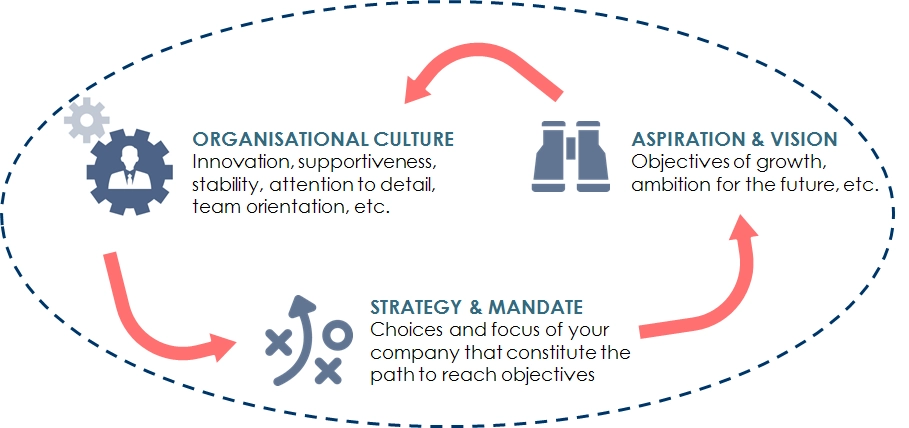
Auditing company culture
The Board and Executive Management, who have always been responsible for culture, are increasingly being held to account when it fails, and organisations are now under more scrutiny to ensure that the culture they embrace is transparent and clearly supports the delivery of their strategy in a manner that is consistent with their values.
However, culture is intangible and elusive. What exactly is the culture of an organisation? How can it be defined? How can it be assessed? Where it is not working how can it be changed?
Following a number of years of research, Mazars has developed a structured tool to assist organisations in auditing culture. This tool helps organisations to define their ‘target’ or desired culture, and then measures actual culture across the organisation against that target. Finally, it assists in defining a plan to address any material gaps between target and actual culture, in particular those that create a risk that the organisation won’t be able to achieve its strategy or deliver on its mandate.
But firstly, what exactly do we mean by culture?
What is Culture?
Schein[1] describes culture as “The pattern of basic assumptions that the group has invented, discovered or developed in learning to cope with its problems of external adaptation or internal integration, and that worked well enough to be considered valid, and therefore be taught to new members as the correct way to perceive, think and feel in relation to those problems”
The culture of an organisation can simply be expressed as ‘how we do things around here’. It is the sum of everything that an organisation stands for and how it operates: its values, its beliefs, its mission, its behaviours and its interactions with employees and customers. These powerful ingredients make up the unique character of an organisation – its culture.
Culture is complex, in an organisation it is everywhere, it is subjective and it is ever changing. Some organisations have several sub-cultures, which is absolutely fine as long as they are all compatible. Culture is not how risk is managed, it is not values, it is not static, it is not conduct, it is not integrity and there is no such thing as a ‘good’ culture, rather a strong culture – one which supports the organisation in the achievement of its objectives.
Mazars research on culture
The Mazars has spent a number of years studying culture, and in a recent research report by Mazars, Board Leadership in Corporate Culture[2] , in association with Board Agenda and INSEAD, our research identified that while believing that the culture of the organisation can be influenced from the top, particularly through by the chief executive officer, only one in five board members believe they are spending the right amount of time addressing cultural issues.
Additional key findings from the report included:
- Setting the right tone from the top is overwhelmingly seen as the main way that a board can influence organisational culture.
- Culture is ranked third by boards in terms of importance, behind only strategy and financial performance.
- 40% of board members believe they either do not devote enough time to cultural issues or that culture is not valued as a discussion topic at board level.
- Half say their board is “reasonably clear” on the desired culture, while a third are “not very clear” or say there is no discussion. Only one-fifth “fully consider” their culture.
- A third of boards are not confident that they have the right information on their culture, and are unclear as to the alignment between the desired culture and that which exists in the business. Only 5% are very confident that there is any clear alignment.
- Half say there are either significant gaps between strategy and culture, or they have not spent much time considering alignment between the two. However, the other half believe they are very clear on alignment between strategy and culture, or that their strategy is broadly consistent with their culture.
- 43% indicate that the culture of the board itself is seldom discussed at board meetings, though a third say the board’s culture is always assessed during a board evaluation.
- There is a three-way split on opinion over managing the risks associated with culture: 36% say such risks are fully embedded in their risk-management systems; 32% say that while not part of formal management, it is discussed at board level; and 31% do not routinely consider the risks associated with culture.
- Directors are generally inward-looking when considering their culture: two-thirds rely on employee feedback to assess existing culture. While half also consider customer feedback, an equal number look to ‘risk events’, such as rule breaches for measurement, while 17% say culture is not measured at all.
- 78.3% of investors state that they would like to see more extensive reporting on culture.
- Employees are the main targets for cultural change programmes: enhancing employee motivation and productivity was cited as the number-one reason type of cultural change programme that most organisations undertake.
Overall, the findings indicate that although boards are aware of how important the culture is to the success of an organisation, boards have yet to find a way to set, asses and change culture in a meaningful way.
Auditing culture
Boards and audit committees are increasingly having to examine the concept of culture and assess whether the culture in their organisation is strong or weak – supportive of their strategy and mandate or otherwise. Executive management teams are examining what aspects of culture they should change and how.
As a result, many HR and internal audit functions in both the public and private sectors are being asked to conduct a review or audit of their organisational culture. Many are not sure where they should start.
The Mazars cultural audit tool
The Mazars cultural audit – the Cultural Compass, which has been developed by a combination of auditors, behavioural scientists and human resource professionals, has been designed to support the challenging process of auditing culture.
This audit of culture starts by assisting the board or executive management team in defining their ‘target’ or desired culture. This forms a baseline for the audit and the tool is then used to determine actual culture against this base.
The Cultural Compass is based on the belief that culture is like the organisational immune system, it keeps the organisation healthy when working well. Just like an immune system it works on the basis of triggers and responses.


The Cultural Compass examines culture across six dimensions as outlined in the diagram below. These dimensions encompass the most important trigger and response elements of culture. In turn, cultural triggers and responses are examined by auditing triggers and responses across 60 variables grouped under these dimensions.
Mazars Cultural Compass
The results can often be challenging with significant divergence in key dimensions or in specific areas of the organisation from the desired culture.
The benefits of conducting a cultural audit
So, what can an organisation do with the results of a cultural audit? The key is to focus on a small number of specific and important cultural gaps and the behaviours that have the greatest impact on these gaps. Changing a culture purely through top down messaging, training or development programmes seldom changes people’s beliefs or behaviours. In general, cultural change will only occur when senior leaders act as role models explicitly modelling the desired behaviours and beliefs and work collaboratively to embed the desired culture in everything the organisation does.
For more information on conducting a cultural review with Mazars, contact Dera McLoughlin, Partner, Mazars.
[1] Schein 1986
Want to know more?




